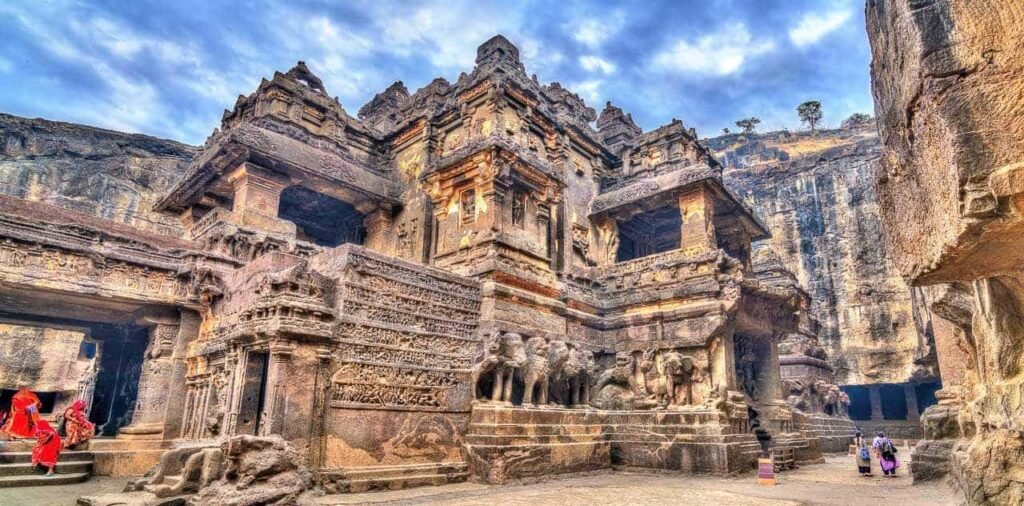Exploring the Majestic Ajanta and Ellora Caves of India
India is home to countless cultural treasures, but few places can match the awe-inspiring wonder of the Ajanta and Ellora Caves. Nestled in the rugged hills near Aurangabad, Maharashtra, these rock-cut cave complexes are not only UNESCO World Heritage Sites but also some of the greatest artistic achievements of ancient India.
Whether you’re a history buff, art enthusiast, spiritual seeker, or simply a curious traveler, Ajanta and Ellora offer a journey into the heart of Indian civilization — carved in stone, colored in fresco, and infused with centuries of wisdom.

Where Are the Ajanta & Ellora Caves?
Located in western India, about 100 km from Aurangabad city, the Ajanta and Ellora caves sit in a tranquil, rocky region that once flourished under ancient trade and spiritual activity. They are:
- Ajanta Caves – 2 hours from Aurangabad
- Ellora Caves – 40 minutes from Aurangabad
- Best Time to Visit – November to March is ideal, but even in May, you can enjoy them with early starts, light packing, and smart travel tips.
Direct flights connect Aurangabad to Mumbai, Delhi, and Hyderabad, making the caves an easy add-on to any Indian itinerary.
The Ajanta Caves: A Buddhist Masterpiece in Stone
Dating back to between the 2nd century BCE and 6th century CE, the 30 Ajanta caves were carved into a horseshoe-shaped cliff overlooking a peaceful river gorge. Entirely dedicated to Buddhism, these caves served as monasteries, prayer halls, and retreats for monks.
Highlights:
- Cave 1: Home to some of the finest murals, including the famous Bodhisattva Padmapani painting.
- Cave 2: Known for its vibrant ceiling paintings and detailed depictions of daily life.
- Cave 26: A remarkable hall with a massive seated Buddha in teaching posture, surrounded by intricate carvings.
These caves tell the Jataka tales—stories of Buddha’s previous lives—and reflect the Gupta style of art, showcasing grace, spirituality, and emotion in every figure.
💡 Tip for international visitors: Ajanta’s artwork predates the Italian Renaissance by centuries, making it a treasure trove for lovers of ancient art and history.
The Ellora Caves: Where Faiths Unite in Stone

The Ellora Caves, constructed between the 6th and 10th centuries CE, are a spectacular fusion of Buddhist, Hindu, and Jain monuments—all carved side by side in peaceful harmony.
Highlights:
- Cave 16 (Kailasa Temple): An architectural marvel carved top-down from a single rock. It’s one of the largest monolithic temples in the world, dedicated to Lord Shiva.
- Cave 10 (Buddhist Carpenter’s Cave): Known for its ribbed, wooden-like ceiling and meditative Buddha image.
- Jain Caves: Featuring delicate carvings and symbolic artwork from the 9th century.
The Ellora complex is a living testament to India’s pluralism and creative genius, where stone transforms into narrative, theology, and timeless design.
Travel Tips for First-Time Visitors
- Getting There: Fly into Aurangabad, then take a cab or private transfer to the sites.
- Where to Stay: Choose from boutique hotels, heritage resorts, or comfortable guesthouses in Aurangabad.
- What to Wear: Breathable clothing, walking shoes, sunscreen, and a hat are essential—especially in warmer months like May.
- Local Guides: Hiring a guide is highly recommended to understand the cave stories, symbolism, and historical context.
Suggested 3-Day Itinerary
Day 1:
- Arrive in Aurangabad
- Visit Bibi Ka Maqbara, a mini-Taj Mahal
- Explore Daulatabad Fort
Day 2:
- Full-day trip to Ajanta Caves (start early!)
- Packed lunch and return by evening
Day 3:
- Visit Ellora Caves, Kailasa Temple, and Grishneshwar Temple
- Return for local market exploration or a relaxing dinner
Responsible Travel & Cultural Etiquette
- Avoid flash photography to protect ancient murals.
- Dress modestly and be respectful—some caves are still active places of worship.
- Don’t touch the paintings or carvings, as they are fragile and irreplaceable.
Ajanta & Ellora vs Other Indian Heritage Sites
Unlike the open-air ruins of Hampi or the sculpted temples of Khajuraho, Ajanta and Ellora are rock-cut caves—they weren’t built, they were excavated. What you see today is carved directly from mountain rock, using simple tools, centuries before modern machinery. It’s humbling, inspiring, and surreal all at once.
Why Ajanta & Ellora Should Be On Your India Bucket List
Visiting these caves is more than just sightseeing—it’s a walk through 2,000 years of Indian philosophy, art, and imagination. For travelers from the West, it’s an eye-opening look into the depth of ancient Eastern traditions—wrapped in serenity, mysticism, and breathtaking beauty.
Whether you’re doing the Golden Triangle, exploring South India, or seeking something extraordinary, don’t miss this detour into India’s spiritual and artistic past.
Ready to Explore Ajanta & Ellora?
We offer customizable travel packages that include:
- Guided heritage tours
- Comfortable stays
- Golden Triangle + Ajanta/Ellora combinations
- Cultural extensions like wine tours in Nashik or spiritual journeys in Shirdi
Contact us today to plan your Ajanta-Ellora journey — and step into one of the world’s greatest stories carved in stone.



